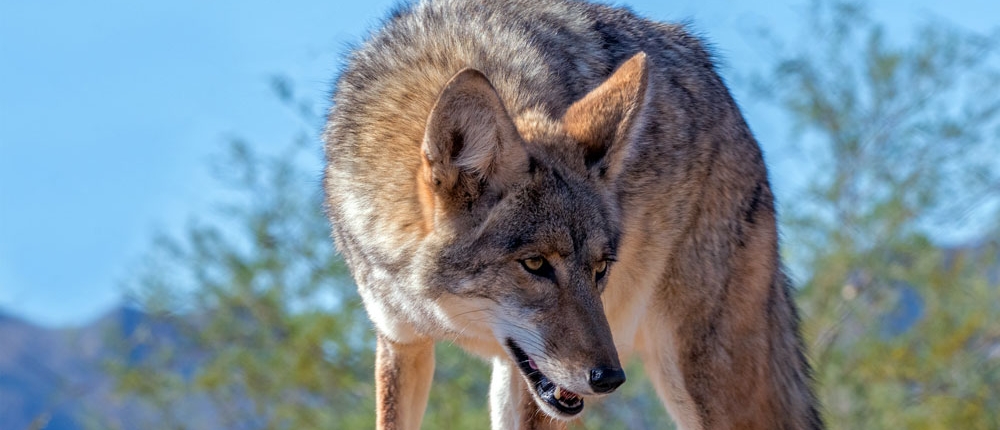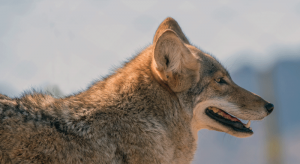What to Do if the Coyote is Not Scared of People and Acting Aggressive?
 The howls of coyotes from a distance are fascinating for many people. Probably because they are generally nocturnal and rarely seen, save for the few times that you might catch a glimpse of them as they wander through a territory in search of food. Even in those scenarios, their natural behavior is to run away from humans. However, coming face-to-face with a brazen coyote can leave a scary impression. How did it obtain this presumptuous attitude? More importantly, what should you do when faced with aggressive behavior? In this post, we’ll answer these pressing questions.
The howls of coyotes from a distance are fascinating for many people. Probably because they are generally nocturnal and rarely seen, save for the few times that you might catch a glimpse of them as they wander through a territory in search of food. Even in those scenarios, their natural behavior is to run away from humans. However, coming face-to-face with a brazen coyote can leave a scary impression. How did it obtain this presumptuous attitude? More importantly, what should you do when faced with aggressive behavior? In this post, we’ll answer these pressing questions.
Why a coyote might not be scared of people?
It all boils down to one word – ‘Habituation’. Habituation is a decrease in response to an external stimulus after prolonged exposure to it. In this context, when a coyote becomes accustomed to having humans around, it gradually loses its fear of humans. This primarily happens when a coyote is being fed by humans, either deliberately or indirectly. If a coyote obtains food from human settlements in the form of handouts, pet foods left outside, unsecured garbage, it begins to associate humans with food. Coyotes who become dependent on this newly found food source tend to approach humans, and may invariably exhibit tamed or aggressive behavior.
What to do when faced with an aggressive coyote?
Coyote attacks on humans are extremely rare. Even when they occur, they are mostly always caused by a habituating coyote. Some of the reasons for these conflicts include:
- A coyote attacking your pet
Coyotes generally prey on small animals like mice, voles, and rabbits. However, habituated coyotes will not hesitate to attack cats and even dogs. Sometimes going as far as to attack a leashed dog. When trying to save your beloved pet from these attacks, fearless coyotes tend to fight back. - Rabid Coyote
A rabid coyote will become less fearful and more aggressive. Although an attack from a rabid coyote is extremely rare, they do occur. If you are bitten by a coyote, you should seek medical attention immediately.
When faced with an aggressive coyote, you should do these two things:
-
- Hazing
Hazing is a method used to either deter an animal or discourage undesirable behavior. Some of the most common methods include:- Screaming and waving your arms while you approach the coyote.
- Using noisemakers like whistles, air horns, and bells to produce a deafening noise.
- Throwing a projectile towards the coyote. Try throwing small rocks, tennis balls, or cans in the direction of the coyote. Do not specifically throw the object at the coyote!
- Shooting water guns, pepper sprays, or bear repellents will help deter the coyote.
- Hazing
When hazing a coyote, here are some important things to remember:
-
- Never run away from a coyote!
- If the coyote refuses to leave, intensify your hazing while you move closer to it. It will run away.
- Continue hazing until the coyote leaves the area entirely!
- A coyote that has been previously hazed might return. Continue to haze at it like before. After, at most two times, it should be gone for good.
- Report to the Appropriate Authority
Aggressive behavior should be reported to the local police or animal control office. A coyote that has bitten a person is usually removed from the population. Most health departments mandate that such a coyote is tested for rabies. This involves decapitating its head and preserving it in ice before sending it to the laboratory. Coyotes should never be killed for unwarranted reasons.

Conclusion
Ultimately, coyote attacks usually occur when they become habituated to humans. Therefore, to reduce the risk of such an attack, ensure that no food sources are lying indiscriminately around your vicinity. Ensure that you maintain the fear that they have for humans.
